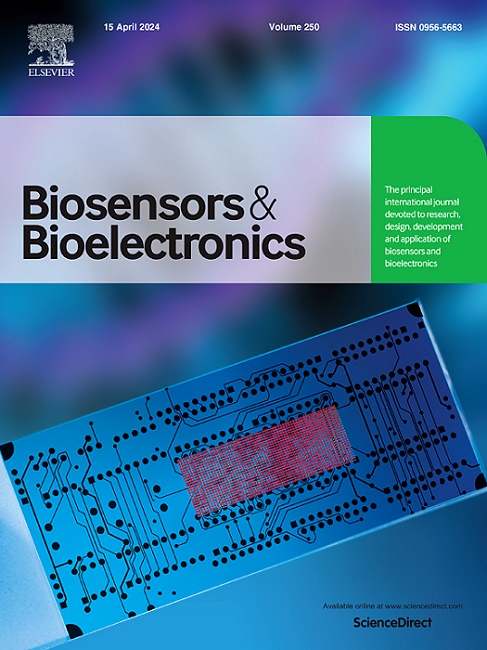将z型异质结的释放组分转移到对侧光电极上:用于自供电生物传感的光燃料电池双电极合作信号放大策略
IF 10.5
1区 生物学
Q1 BIOPHYSICS
引用次数: 0
摘要
信号放大策略的探索是自供电光电化学生物传感器发展的重要环节。在此,我们开发了一种双电极合作的信号放大模式,通过将Z-scheme异质结的释放组分转移到相对的光电极上,并将其与DNA熵驱动的放大设计相结合,用于超灵敏的SPECs生物分析。具体来说,模型分析物microRNA-155触发熵驱动的DNA电路释放大量的输出DNA,这些DNA可以与TiO2纳米球和Sb2S3/Au光阳极之间的部分互补DNA双链竞争性杂交,从而启动TiO2纳米球的释放。在这种情况下,光阳极上形成的z型异质结将受到破坏,产生光阳极电位的正位移,从而降低spec的开路电压(EOCV)。同时,这些释放的TiO2纳米球表面的DNA与固定在CuO/Cu2O光电阴极上的发夹DNA进一步杂交,形成ii型异质结,光电阴极电位负移。因此,可以进一步降低spec的EOCV以实现级联信号放大。本研究为双电极合作视角下的信号放大策略家族增加了一名新成员,将在SPECs乃至其他基于燃料电池的生物传感器领域引起更多关注。本文章由计算机程序翻译,如有差异,请以英文原文为准。
Transferring the released component of Z-scheme heterojunction onto opposite photoelectrode: A dual-electrode-cooperating signal amplification strategy in photo fuel cell for self-powered biosensing
Exploration of signal amplification strategy is an important link during the development of self-powered photoelectrochemical biosensors (SPECs). Herein, we develop a dual-electrode-cooperating signal amplification mode by transferring the released component of Z-scheme heterojunction onto opposite photoelectrode, and integrate it with DNA entropy-driven amplification design for ultrasensitive SPECs bioanalysis. Specifically, microRNA-155, the model analyte triggers the entropy-driven DNA circuit to release large amounts of output DNAs, which can competitively hybridize with the partial complementary DNA double strand between TiO2 nanospheres and Sb2S3/Au photoanode for initiating the release of TiO2 nanospheres. In this case, the formed Z-scheme heterojunction on photoanode will suffer destruction, generating a positive shift of photoanode potential and thus a decrease in the open circuit voltage (EOCV) of SPECs. Meanwhile, the DNA on the surfaces of these liberated TiO2 nanospheres can further hybridize with the hairpin DNA anchored on CuO/Cu2O photocathode, leading to the formation of type-II heterojunction and the negative shift of photocathode potential. Therefore, an additional decrease in the EOCV of SPECs can be realized for cascading signal amplification. This work adds a new member to the family of signal amplification strategies from dual-electrode-cooperating perspective, which will attract more attentions in the field of SPECs and even other fuel cells-based biosensor.
求助全文
通过发布文献求助,成功后即可免费获取论文全文。
去求助
来源期刊

Biosensors and Bioelectronics
工程技术-电化学
CiteScore
20.80
自引率
7.10%
发文量
1006
审稿时长
29 days
期刊介绍:
Biosensors & Bioelectronics, along with its open access companion journal Biosensors & Bioelectronics: X, is the leading international publication in the field of biosensors and bioelectronics. It covers research, design, development, and application of biosensors, which are analytical devices incorporating biological materials with physicochemical transducers. These devices, including sensors, DNA chips, electronic noses, and lab-on-a-chip, produce digital signals proportional to specific analytes. Examples include immunosensors and enzyme-based biosensors, applied in various fields such as medicine, environmental monitoring, and food industry. The journal also focuses on molecular and supramolecular structures for enhancing device performance.
 求助内容:
求助内容: 应助结果提醒方式:
应助结果提醒方式:


